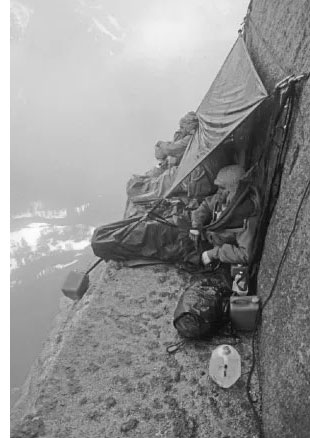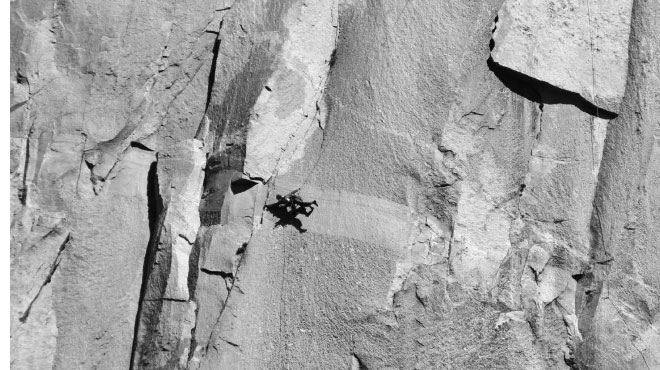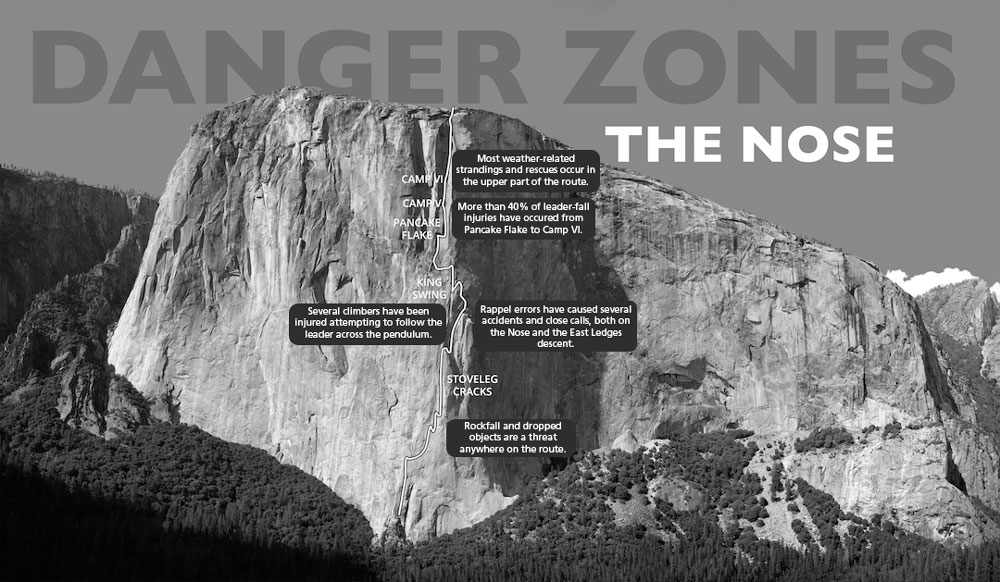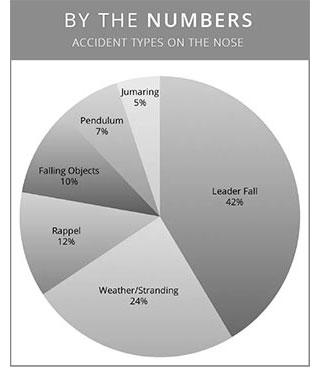At 5.9 C2, the Nose is considered to be the easiest full-length route on El Capitan, which makes it extremely popular and draws relatively inexperienced big-wall climbers. But the Nose also is a complex climb, requiring a large repertoire of techniques that may be unfamiliar to newcomers.
In the nearly 60 years since it was first climbed, the Nose has seen more than its share of accidents. We surveyed the last 41 years of incidents reported in Accidents in North American Mountaineering (1974–2014 publication dates). Of the 101 reports from El Capitan published during that time span, 41 (by far the largest concentration) covered incidents on the Nose, involving 44 separate parties.
The Nose is unusual for El Capitan because all of its bivouacs are on natural ledges and because there is a high percentage of free climbing on the route, compared with the steeper, blanker aid climbs to either side. (Only the Salathé Wall is similar in these ways.) Nevertheless, the most common accidents on the Nose, including leader falls, falling objects, and stranding in foul weather, are also common on other El Cap routes, and many of the lessons apply to other big-wall climbs, both in Yosemite Valley and elsewhere. Indeed, many of the accidents that happen on El Capitan are similar to those that occur on smaller crags, but the consequences are magnified by the scale of the cliff.
The National Park Service does not require registration for climbing in Yosemite, so we are unable to say what percentage of all climbs of El Capitan end with these outcomes. Nonetheless, it is our hope we can call attention to the most common accidents and discuss what might be done to prevent future climbers on the Nose from appearing in these pages.
Leader Falls And Protection
More than 40 percent of the incidents on the Nose reported in the pages of Accidents have involved leader falls. In most cases, the reports cited insufficient or poorly placed protection. In all cases but one, one or more pieces of protection pulled out. (The exception was a fatal incident in 1977 in which a climber temporarily clipped into a bight on a rope instead of tying in directly as he maneuvered to free a stuck rope. The rope then came unclipped when he fell.) While a few of the pieces of protection that pulled out were fixed, the majority had been placed while free climbing or aiding.
Among the reports involving a lead fall that referenced the climber’s experience level, inexperience did not correlate to the likelihood of an accident. In other words, highly experienced climbers have injurious or fatal falls on the Nose—in some cases when they choose to run it out instead of placing sufficient pro.
Although the leader falls reported in these pages were spread along the full length of the wall, more than 40 percent of them happened along the pitches between Pancake Flake and Camp VI (pitches 23, 24, 25, or 26, depending on the individual report’s pitch count for the route). The pitch directly above Camp V, leading to the Glowering Spot, has seen multiple accidents, in part because of the ledges that lie just below the harder climbing on this pitch. All of the incidents on this pitch occurred when an aid piece pulled out, suggesting the need for more practice with aid placements and movement before attempting the Nose. Generally, most leader-fall reports described one or more of the following subjective factors:
Back Cleaning
- “Although he carried three of each size of camming device…[he] felt he should back-clean…his protection.”
- “He back-cleaned the other nut to get the quickdraw, because he felt he was running out of them and didn’t want to disassemble the quickdraws on his cams.”
- “He attributes the long fall to having back-cleaned a good piece, thinking he’d need it later.”
Insufficient Protection
- “[He] had placed no protection above the belay station bolts. He fell feet-first about 30 feet.”
- “…so I skipped clipping the bolts and climbed higher.”
- “Falling on the first pitch is a common occurrence. Not having adequate protection in this situation is the reason climbers fall to the deck.”
Cascading Failure
Where protection was placed, longer-than-expected falls almost always resulted from multiple pieces of gear failing:
- “[He]…was standing on a fixed wired nut when it broke. A small Friend he had placed pulled out during his fall.”
- “At least two failed pieces, possibly fixed, contributed to his striking the ledge.”
- “While standing on a TCU (#0 or #1), it popped from the crack. He also pulled the stopper below the TCU.”
As with many big-wall routes, the recommended gear list for the Nose is extensive, including two to three sets of cams and nuts. Climbers may lighten their racks for a variety of reasons—and consequently may need to back-clean or run it out on a pitch—but doing so should always be balanced against the ability to protect pitches adequately. Moreover, as with plane crashes, falling itself is rarely problematic—it’s the sudden impact with a ledge, flake, or corner that causes injury. Be aware of such obstacles before making the decision to back-clean or run it out.
Finally, consider how the rope is running through your protection and whether the pieces below you may be compromised when your rope suddenly goes taut in a fall. See “Know the Ropes” in this edition for more information on extending protection pieces to keep them from popping out in a fall.
Weather & Being Stranded
 Veteran YOSAR ranger John Dill makes a succinct point about Yosemite Valley weather in his essential essay “Staying Alive” [see box below] by citing two incidents from the same date, just one year apart:
Veteran YOSAR ranger John Dill makes a succinct point about Yosemite Valley weather in his essential essay “Staying Alive” [see box below] by citing two incidents from the same date, just one year apart:
- On Oct. 11, 1983, a climber on El Cap collapsed from heat exhaustion.
- On Oct. 11, 1984, a party on Washington Column was immobilized by hypothermia.
Dill adds: “You can expect this range of weather year-round.”
Weather was a major factor in a quarter of the incident reports for the Nose. Not only is the weather unpredictable year-to-year, as Dill points out, but storm systems can quickly and unexpectedly develop during the four to five days most parties spend on the Nose, especially (but not exclusively) during the popular fall season and winter.
It’s worth noting that no weather-related incidents were reported in the first half of the climb. In all likelihood, the weather forecast was promising for the period the parties assumed it would take to summit, but then the weather went bad when they were higher up. Moreover, retreat is easier in the first half of the route than in the second half.
Amplifying the serious effects of unexpected foul weather is the topography of the route. Natural ledge camps coax climbers into leaving robust (but heavier) portaledges behind in favor of bivy sacks or tarps. And on the upper pitches, inclement weather often means impromptu waterfalls and water funneling down the cracks from rain or melting ice. The areas around Camp V and VI and above are particularly vulnerable to run-off.
|
Staying Alive
In addition to providing dozens of accident analyses for this publication over the years, longtime YOSAR ranger John Dill wrote "Staying Alive," an analysis of the Yosemite climbing accidents between 1970 and 1990. It is a trove of useful advice gleaned from decades of analyzing accidents (many on the Nose), and it should be considered essential reading for anyone considering their first El Cap route. You can find it in the Supertopo guidebook to El Capitan or at the Friends of YOSAR website.
|
When faced with impending storms, many climbers covered in Accidents chose to race the weather to the top rather than retreat. This is a dicey proposition since the higher pitches can ice over, and tired and possibly hypothermic climbers may struggle on the steep, strenuous upper pitches. In two separate incidents, climbers racing storms died on the last pitch of the route. Also, as one incident analysis pointed out, “The summit is only halfway to safety. Had [they] reached the top, they would have found themselves… facing deep snow, high wind, low visibility, and dangerous terrain.”
At least one party of climbers involved in a weather-related incident specifically had chosen the Nose because descent is possible from any pitch. However, when the situation became critical, they did not have the confidence to negotiate a retreat. In other cases, climbers had adequate gear and shelter to wait out a storm, but lacked sufficient food and water.
While the weather forecast might give guidance on whether and when to start an attempt, it shouldn’t be construed as permission to neglect key areas of readiness. Shelter and clothing should be storm-ready and field-tested. Synthetic clothing and sleeping gear are essential. Parties should carry ample food and water to allow them to wait out poor conditions. Lastly, climbers should study retreat routes and carry the gear needed to make multiple rappels in serious weather.
Rockfall & Falling Objects
For some time, it has been considered unethical (and in Yosemite illegal) to jettison objects from a big-wall climb. In addition to the “ick factor” of a poo bag intentionally chucked from 1,500 feet, nearly any object dropped even half a pitch can present a serious threat to those climbing below.
When rocks or flakes come loose, the results can be catastrophic. In 1988 there were two incidents in which falling blocks severed lead ropes. One party was “lucky” to escape with the belayer only suffering a broken arm. In the other case, the leader was already falling when a rock cut his rope and he fell nearly 2,000 feet to the Valley floor.
Smaller rocks (or carabiners, cams, water bottles, food containers, or any other object) can cause serious injuries. As described in a 1993 report, a climber ascending fixed lines to Sickle Ledge was sent to the medical clinic with head lacerations after being beaned with rocks dropped by other climbers already on the ledge.
Helmets are a must. But a helmet cannot protect climbers against large falling blocks. For the sake of climbers below, all climbers on El Capitan must take great care to avoid pulling off loose rocks when placing protection, managing the rope, and maneuvering around ledges or flakes. In addition, when possible, belayers should consider an anchor set-up that gives them a little freedom to dodge falling objects, as long as the set-up does not compromise the belay. Finally, during the weeks and months leading up to an ascent, climbers should stay up to date on the route by reading online trip reports and other updates that might mention hazardous flakes or loose blocks to avoid.

Pendulums
Three accidents reported in the past four decades involved pendulums (two on the King Swing and one on the pitch seven traverse to the crack leading to Dolt Hole). In all three cases, climbers underestimated their acceleration and collided with rock features, resulting in significant injury. [Editor’s note: Another King Swing accident took place in 2014. See page 52.]
All three of these pendulum accidents involved a climber following the pitch, after the leader had successfully made the pendulum. Usually the second must lower himself out from the anchor he’s leaving before starting a swing. It’s easy to underestimate the amount one needs to lower before making a safe pendulum traverse. While most climbers have experience falling vertically, many fail to realize that swinging through a 90-degree arc can generate just as much speed—and at an angle that exposes vital organs to the impact. This suggests that seconds need to lower as far as they can with the extra rope they have available—or, quite likely, use a second rope to ensure an adequate lower-out.
Descent
The Nose is equipped to allow a rappel descent from any pitch of the climb. However, route-finding during the descent is crucial. In separate incidents, two parties became stranded after getting lost on the standard rappel route. One was able to continue once visibility improved. The other was unable to reascend and, having inadequate water, required a rescue.
Other cases involved the more typical difficulties and dangers of rappelling— perhaps amplified by exposure and the necessity for multiple rappels. One climber required assistance after a knot became stuck when rappelling, and another had a close call when an attempt to cut a T-shirt free from a belay device resulted in severed rappel ropes. One accident with multiple fatalities may have resulted in part from anchor failure.
Various El Capitan climbers have run into trouble on the standard East Ledges descent route from the summit, including one fatal accident. The East Ledges descent combines rappelling, downclimbing, and talus scrambling, at a time when climbers are likely tired and toting heavy haul bags. Despite one’s understandable eagerness to return to the Valley floor, it may be safer and more relaxing to spend another night on the summit and do the descent in the morning.
In addition to studying the rappel route (and carrying a topo of the descent) in case it’s necessary to bail from the climb, the fundamentals of safe rappelling—knotting the rope ends, using a friction backup, and double-checking each rappel set-up before unclipping from the anchor—must be followed when retreating from a big-wall climb. All the more so because retreat is likely happening when climbers are tired or stressed by poor weather.
Final Word
Most of the accidents that happen on the Nose are the same types of accidents that happen elsewhere. Climbers succumb to objective hazards. They take falls and pull out protection. They get tired, overestimate their abilities, or make mistakes. A climb of this scale elevates not only the climber’s ambition, but also the stakes, in a way that only 3,000 feet of towering granite can.
View the complete table of El Capitan incidents reported in Accidents.
 Veteran YOSAR ranger John Dill makes a succinct point about Yosemite Valley weather in his essential essay “Staying Alive” [see box below] by citing two incidents from the same date, just one year apart:
Veteran YOSAR ranger John Dill makes a succinct point about Yosemite Valley weather in his essential essay “Staying Alive” [see box below] by citing two incidents from the same date, just one year apart:

 The Nose of El Capitan began capturing people’s attention well before the first ascent in 1958. Long, aesthetic, and immediately visible upon entering the Valley, it has all the makings of a classic line. At 5.9 C2, the Nose is considered to be the easiest full-length route on El Capitan, which makes it extremely popular and draws relatively inexperienced big-wall climbers. But the Nose also is a complex climb, requiring a large repertoire of techniques that may be unfamiliar to newcomers.
The Nose of El Capitan began capturing people’s attention well before the first ascent in 1958. Long, aesthetic, and immediately visible upon entering the Valley, it has all the makings of a classic line. At 5.9 C2, the Nose is considered to be the easiest full-length route on El Capitan, which makes it extremely popular and draws relatively inexperienced big-wall climbers. But the Nose also is a complex climb, requiring a large repertoire of techniques that may be unfamiliar to newcomers.